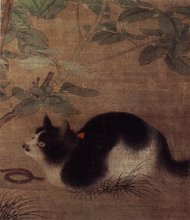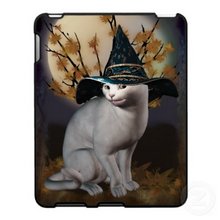Sacred Felines: History of the Cat Part 2

어제 배웠던 것처럼, 고양이 역사는 다방면으로 복잡한 주제입니다. 과학에 관한 한 고양이 훈육의 초기 징후는 농업 사회의 도래와 함께 고대 그리스에서 시작되었다. 나중에 고양이의 역사에서, 고대 이집트인들은 신으로 그들을 숭배하기 시작하고, 고양이의 역사에서 처음으로, 고양이는 왕실 치료의 맛을 가지고.
This history of the cat's worship began as a totemic practice, (the worship of an animal as a spiritual symbol) but was later further organized with the cat holding a legitimate spot in the Egyptian pantheon. There were three cat goddesses of note: Mafdet, Bast, and Sehkmet. Mafdet was the goddess of Justice. Bast began as a lion goddess but eventually became more cat-like as her role was marginalized. She was the protective patron deity of Lower Egypt, as well as a handmaiden and protector of the sun god, Ra. Sehkmet also began as a lioness, but ended up becoming more cat-like over time. She replaced Bast as the protector of Ra and the pharaohs.
기원전 390 년경에 고양이를 경배했던 고대 이집트의 주요 종파가 해산되고 고양이 began to lose their significance, although their influence never completely fizzled out. Because of their awesome hunting skills, cats have always been valued residents of whatever culture and time period they happen to inhabit. Cat history is filled with owners thankful to be pest-free.
The history of the cat isn't limited to a single location though. They are valued companions all over the globe. During the Song Dynasty in China around a thousand years ago, cats were treated as the favored pets among nobility. They went so far as to advertise and sell fish exclusively for cat feeding in the ancient Chinese markets. In much of Europe and the United States, cats enjoyed a more
began to lose their significance, although their influence never completely fizzled out. Because of their awesome hunting skills, cats have always been valued residents of whatever culture and time period they happen to inhabit. Cat history is filled with owners thankful to be pest-free.
The history of the cat isn't limited to a single location though. They are valued companions all over the globe. During the Song Dynasty in China around a thousand years ago, cats were treated as the favored pets among nobility. They went so far as to advertise and sell fish exclusively for cat feeding in the ancient Chinese markets. In much of Europe and the United States, cats enjoyed a more infamous sort of notoriety. They became associated with witches as familiars and servants of the devil.
infamous sort of notoriety. They became associated with witches as familiars and servants of the devil.
This superstition persists in culture even today, as people will always assume a black cat crossing their path is an ill omen. Myths even include stories of cats sadistically smothering infant children by stealing all of the air from their noses. The crazy thing about that one is it may actually be rooted in reality. Cats have been known to lie on top of infant children for warmth, in some cases suffocating the child. However, in the United Kingdom it is considered good luck for a black cat to enter a home or climb aboard a ship. It seems human beings are often as ambivalent toward cats as they are towards us.
고양이의 역사는 풍부하고 다양한 연구 주제라는 것을 알기 쉽습니다. 이 두 블로그 게시물을 통해 우리가 좋아하는 고양이를 둘러싼 수많은 이야기와 민속의 표면을 거의 긁어 보지 못했습니다. 한 가지는 확실합니다. 나쁜 언론이나 우대를 다루는 것이 든 관계없이이 고양이와의 복잡한 관계는 곧 끝나지 않습니다.
This history of the cat's worship began as a totemic practice, (the worship of an animal as a spiritual symbol) but was later further organized with the cat holding a legitimate spot in the Egyptian pantheon. There were three cat goddesses of note: Mafdet, Bast, and Sehkmet. Mafdet was the goddess of Justice. Bast began as a lion goddess but eventually became more cat-like as her role was marginalized. She was the protective patron deity of Lower Egypt, as well as a handmaiden and protector of the sun god, Ra. Sehkmet also began as a lioness, but ended up becoming more cat-like over time. She replaced Bast as the protector of Ra and the pharaohs.
기원전 390 년경에 고양이를 경배했던 고대 이집트의 주요 종파가 해산되고 고양이
 began to lose their significance, although their influence never completely fizzled out. Because of their awesome hunting skills, cats have always been valued residents of whatever culture and time period they happen to inhabit. Cat history is filled with owners thankful to be pest-free.
began to lose their significance, although their influence never completely fizzled out. Because of their awesome hunting skills, cats have always been valued residents of whatever culture and time period they happen to inhabit. Cat history is filled with owners thankful to be pest-free.
 infamous sort of notoriety. They became associated with witches as familiars and servants of the devil.
infamous sort of notoriety. They became associated with witches as familiars and servants of the devil.This superstition persists in culture even today, as people will always assume a black cat crossing their path is an ill omen. Myths even include stories of cats sadistically smothering infant children by stealing all of the air from their noses. The crazy thing about that one is it may actually be rooted in reality. Cats have been known to lie on top of infant children for warmth, in some cases suffocating the child. However, in the United Kingdom it is considered good luck for a black cat to enter a home or climb aboard a ship. It seems human beings are often as ambivalent toward cats as they are towards us.
고양이의 역사는 풍부하고 다양한 연구 주제라는 것을 알기 쉽습니다. 이 두 블로그 게시물을 통해 우리가 좋아하는 고양이를 둘러싼 수많은 이야기와 민속의 표면을 거의 긁어 보지 못했습니다. 한 가지는 확실합니다. 나쁜 언론이나 우대를 다루는 것이 든 관계없이이 고양이와의 복잡한 관계는 곧 끝나지 않습니다.





 모든 포스트
모든 포스트 팁과 트릭
팁과 트릭 건강과 웰빙
건강과 웰빙 제품 리뷰
제품 리뷰 재밌는 이야기
재밌는 이야기





